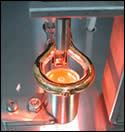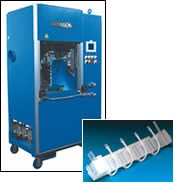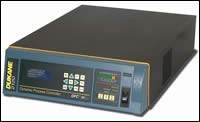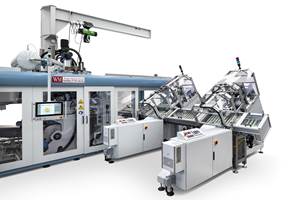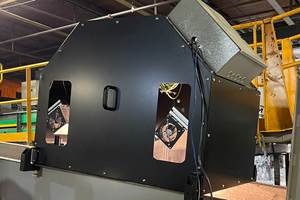New Welding Technologies — Why They Grabbed Attention at NPE
The spotlight in plastics welding and assembly at NPE 2003 was focused on laser, infrared, and ultrasonic equipment.
The spotlight in plastics welding and assembly at NPE 2003 was focused on laser, infrared, and ultrasonic equipment. In each case, a number of notable advances were showcased. Improvements in hot-plate and vibration welding were more incremental. These will be reported in an upcoming issue.
Four new players in laser welding equipment made their North American debut at the show, roughly doubling the number of available sources. Laser welding has sparked lots of attention in recent years—mostly in Europe—as a non-contact assembly method that minimizes generation of particulates and gently handles sensitive, complex parts like medical devices, auto under-hood assemblies, and sensor-laden electronics.
Laser welding of clear or colored parts that are transparent to infrared (IR) energy was demonstrated for the first time at a show. Previously, one of the parts being joined had to be IR-absorbing, which limited laser welding’s reach.
NPE also saw the commercial launch of non-laser IR welding and heat-staking technologies, with production-ready equipment on display for the first time. IR thermal assembly utilizes special IR heating elements (e.g., ceramic or quartz), which are potentially faster-acting and more energy efficient.
New ultrasonic welding controls that operate in multiple modes (not just time based) were another area of emphasis at the show. Welding parts on the basis of energy and weld depth—both relative and absolute—opens the way for equipment to be self-diagnostic and self-correcting, translating into shorter cycles, better welds, and improved part quality.
New laser suppliers
Dukane announced an alliance with a French maker of laser equipment that up to now has been used just for metal joining. This equipment uses “quasi-simultaneous” technology (rapidly scanning mirrors sweep the laser beam over the weld line many times per second) and is capable of both line and contour welding. Dukane will provide the know-how to adapt this equipment for plastics use.
A second new entry in laser welding is LaserQuipment, a subsidiary of Germany’s LPKF Laser & Electronics. LPKF supplies diode scanning-type welders in quasi-simultaneous (QS) and contour (K) versions. (Contour welders move the part under a focused, stationary spot of laser energy.) A distinctive feature is the top-down clamp design that allows units to mount easily beside conveyor belts in automated lines.
Another newcomer is MTS Telsonic, the U.S arm of Manufacturing Technology Solutions in Switzerland. The company’s LW units have diode-type scanning lasers with 50- to 200-W power levels.
Also new to North America is MS Plastic Welders, which displayed a quasi-simultaneous laser welder made by its German parent, a specialist in integrated systems for automotive assembly. The company also makes laser cutters.
More familiar laser equipment suppliers also showed new developments. Branson Ultrasonics has combined diode lasers into banks of different sizes. It claims these IRAM systems are suitable for high-volume, fast-cycling applications like automotive under-hood parts and lighting assemblies. Branson’s three-bank IRAM 20 unit joined intricate plaques in the simultaneous mode at the show. (Simultaneous welding means the laser beam is collimated into a line or curve so that it can expose the entire weld region at once.) Branson demonstrated laser welding of two components that were both IR-transmissive, a feat made possible by spraying IR-absorbing inks developed by Gentex Corp. on one of the parts. Branson and Gentex recently entered a non-exclusive agreement to jointly market Gentex’s Clearweld process for welding IR-transmissive parts. Gentex will optimize inks for use with Branson equipment.
Branson also demonstrated a six-bank IRAM 300 system in welding a brake-fluid reservoir in wide-beam scanning mode. The method sweeps a curtain of energy across the weld zone and is preferred when that zone is relatively large.
Controls for laser welders until now have been limited to time-based operation, in contrast to the multiple modes available for other welding methods. For example, welding by distance is favored when parts require uniformly matched surfaces for a hermetic seal or tight tolerances for a snap fit. Bielomatik’s response was to revise the control software for its Laser Tec welder to make it the first laser unit capable of welding by depth. This function was demonstrated on an automotive oil gauge. The nylon 66 device requires a hermetic seal and close dimensional control, making it a prime candidate for welding by depth.
Meanwhile, Leister Technologies offered two new versions of its Novolas diode-type laser welders. The M (Masking) unit uses photolithographic masks to map out weld geometries. Complex contours can be matched by creating circular or spiral-shaped welds to ensure high-integrity joining of small, intricate parts. Novolas M was shown joining a micro-fluidic device using 100-micron-wide welds.
Also displayed was a Novolas WS (Work Station) unit designed for flexibility in manually loaded lines. The WS model has quick-change welding heads and optical lenses and permits rapid shifts between different laser welding modes (contour, simultaneous, and masking).
IR heating has arrived
Infrared heat welding has ad vanced from the prototype stage to commercial production models for welding and staking. IR welding has potential for replacing hot-plate welding methods, says Heraeus Noblelight sales manager Ed Arneson. Like hot-plate welding, IR heating is used to melt part surfaces before they are pressed together. But IR heat is a non-contact method that yields stronger bonds and costs less than hot-plate welding, Arneson claims. In some cases, IR welding can also challenge ultrasonic welding, as in glass-reinforced materials where it is less destructive of mechanical properties.
IR heating is also an alternative to superheated air and cold metal for heat staking, which are widely used in the automotive sector. Heraeus showed an IR heat-staking system that reportedly offers 50% shorter cycle time, reduced energy use, extended heater life, and less heat in the workplace.
Extol demonstrated three Infrastake IR heat-staking systems: a standard single-head unit, a single-head unit with rotary parts-handling table, and a multi-head unit for high-speed assembly of parts with numerous, predictably located fastening points.
Some competitors voice skepticism about IR heating because it allegedly could degrade plastics, present hazards to workers, and increase generation of volatiles in the workplace. Critics also claim control of IR-heating equipment at present is somewhat haphazard. However, IR systems suppliers emphatically reject all these contentions.
More power and precision
Ultrasonic equipment at the show reflected a trend toward higher power levels (4000 W or above) for welding larger parts and hard-to-weld materials like PP, glass-reinforced resins, and some flexible materials. For example, Sonics & Materials showed a 6000-W, 15-kHz ultrasonic unit designed to join large polyolefin parts.
Branson displayed a 6000-W unit that excels at joining films and fabrics, according to Sylvio Mainolfi, national sales manager. He cited bonding of automotive pedal kick pads to PP carpet and joining ultra-thin nonwoven medical filters.
MTS Telsonic showed for the first time in the U.S. its new 6500-W, high-speed cut-and-seal equipment for nonwovens. The unit’s 1.2-ton force and self-leveling anvil nest are said to ensure trouble-free cutting and sealing of medical pads and filter media.
PET and APET clamshell and blister packaging has long been joined by heat sealing. But the rising recycle content in these containers tends to impair sealing speed and raise costs. Sonitek responded with an ultrasonic sealer said to restore R-PET sealing to cruising speed.
The other evident trend in ultrasonics at the show was better control of the welding process. Dukane demonstrated its latest generation of ultrasonic actuators in combination with a new 30-kHz thruster and new DPC-IVPlus controls. Precision welding by depth is reportedly made more accurate by using a hydraulic rather than pneumatic thrust mechanism.
Ultra Sonic Seal demonstrated a welder-sealer said to offer high accuracy in weld-by-depth operations on flexible medical and electronic parts. Weld-by-depth has traditionally depended on pneumatic actuation, which is subject to drift, but this equipment uses an electric stepper motor to reduce depth tolerances to 0.0002-in.
Forward Technologies launched the Rinco Dynamic ultrasonic welder family (made by a Swiss sister company) in 20- and 35-kHz versions. They have a new generator that offers unprecedented control in multiple welding modes, says David Kravoletz, marketing v.p. He says a servo-pneumatic valve makes these the only ultrasonic welders that “allow truly independent precision control of velocity and force throughout the welding cycle.”
Forward’s control also permits an extra operating mode called “ground detect.” This sets the final actuator position relative to a predetermined ground point, which assists welding and cutting of films, fabrics, and soft polymers by preventing contact (and damage) to the horn and anvil as they converge. Redesign of the clamping fixture also speeds set-up and head-change times.
Stapla Ultrasonics launched a controller that works in multiple welding modes, is optimized for automated lines, and uses 20- and 35-kHz frequencies. The 35-kHz version for more sensitive parts has a reduced footprint, while a mechanical stop protects against damage to horns and fixtures.
In other ultrasonic news, Sonitek has upgraded its workhorse 900- and 1500-W welders by adding chrome-plated columns, modular mounting plates, remote-start cables, and other features to assist their integration into automated operations.
Herrmann Ultrasonics introduced to North America equipment already used in Europe for sealing thin stand-up pouches. Top and bottom seam integrity is critical in these challenging packages.
Ultrasonics For Less brought out a hand-held, 20-kHz ultrasonic welder said to be 50% lighter than any existing version. The system incorporates a rotary indexing table.
Branson also launched upgraded low-power (LP) hand-held welders. Their modular design allows customization for specific applications.
Related Content
LED Signal Tower Available in White, Cleanroom Ready
Werma’s eSIGN LED signal tower is now available in white, with a variety of signaling modes.
Read MoreAutomation in Thermoforming on the Rise
Equipment suppliers’ latest innovations exemplify this trend driven by factors such as labor shortages, higher-speed thermoformers and tighter quality control.
Read MoreMetaspectral to Advance Vision Technology for Recycling
Company received further funding from British Columbia’s CleanBC Plastics Action Fund
Read MorePolyfuze Graphics Corp. Partners With RFID Specialists
To help customers navigate the complexities of RFID technology, Polyfuze has partnered with such companies as HID Global.
Read MoreRead Next
For PLASTICS' CEO Seaholm, NPE to Shine Light on Sustainability Successes
With advocacy, communication and sustainability as three main pillars, Seaholm leads a trade association to NPE that ‘is more active today than we have ever been.’
Read MoreBeyond Prototypes: 8 Ways the Plastics Industry Is Using 3D Printing
Plastics processors are finding applications for 3D printing around the plant and across the supply chain. Here are 8 examples to look for at NPE2024.
Read More


